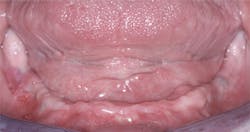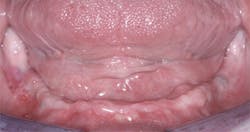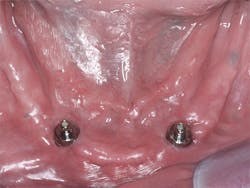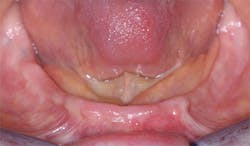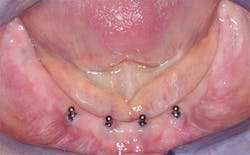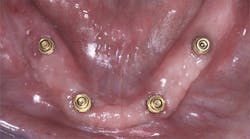Conservative, affordable, implant-supported overdentures
Q: I have many edentulous patients in my practice. Some of them are dissatisfied with my treatment, and I know that they could be served well with implant-supported overdentures. However, the cost of the implants and the prostheses appears to be high, as observed in various articles and ads. Are there ways to make better treatment of the edentulous mandible that are less expensive?
A: Estimates are that there are 35 million edentulous persons in the U.S.1 Although dental root-form implants have been available for several decades, most edentulous persons are unfamiliar with their benefits and availability. In addition to not knowing about implants, another major reason many edentulous patients have not had implants placed are the relatively complex, extensive, and expensive techniques promoted by some dentists and implant manufacturers. It is unfortunate that thousands of edentulous patients have not been introduced to less expensive and less invasive treatments and that the vast majority of dentists are not using implants for edentulous patients.
I will briefly discuss three relatively simple, minimally invasive, and affordable clinical procedures that can be used to treat the majority of edentulous patients.
Overdenture supported and retained by two implants (Figures 1–2)
All restorative-oriented dentists, whether general dentists or prosthodontists, have had the frustrating experience of meticulously making well-fitted complete dentures, only to have the patient complain that the dentures "fall out." Providing two conventional implants (3 mm or greater in diameter) placed in the canine areas results in a significant improvement in denture retention and chewing ability for the patient.2-6 A recent conference chaired by Dr. Jocelyne S. Feine supported the use of this concept, which is becoming well accepted among those dentists who provide implants. If adequate bone is available in the posterior areas of the mouth, and the patient has adequate financial resources, additional implants in the posterior area provide more denture stability and retention. Some of these patients have older dentures that are relatively acceptable, but the dentures need improvement in retention and stability. These dentures can often be relined or rebased after the implants have been placed, which retrofits to the dentures, and they still serve patients well. If a previously made denture is defective and needs to be replaced, making new dentures after the implants have been placed is the alternative.
There are many techniques that can be used for fabrication of a complete denture using two conventional diameter implants for support and retention. However, it is apparent that most dentists do not know the techniques or want to use them, since very few edentulous patients have had the opportunity to have implants. Therefore, I briefly include representative techniques in this article to guide practitioners who have not used implants for edentulous patients. The following is a technique when rebasing or relining the previously made denture and retrofitting it to the two implants:
• Diagnosis, treatment plan, and patient acceptance of the two implants, and reline or rebase of the previously made denture.
• Placement of the two conventional diameter (3 mm or greater) implants. As reported by sales representatives of implant companies, the most commonly used diameter of implants for this purpose is slightly over 4 mm in diameter and about 12 mm in length, depending on the quantity and quality of bone that is present.
• Deciding on whether or not to load the implants immediately after the denture has been rebased. If the implants were placed in bone of adequate quantity and quality, immediate loading - although still somewhat controversial - has been shown to be acceptable.7-11 If there is any question about the acceptability of the bone, immediate loading is not suggested.
• If immediately loading the implants without rebasing the denture, place the housings on the implants, make vented indentations in the underside of the denture over each implant, seat the denture over the implants, making sure the indentations are large enough to allow the denture to seat without touching the housings, and attach the denture to the housings with conventional "pick-up" resin.
• If allowing the implants to be unattached to the denture for a healing period, make the indentations in the underside of the denture as indicated above, and place soft denture reline material into the indentations. Seat the denture into the mouth over the implants without the housings on them. It is suggested to let the implants integrate for four to 12 weeks or even up to a few months depending on the bone quality and quantity. Later, attach the denture to the housings as described above, rebasing if the denture requires that procedure.
If making new dentures, the housings may be placed in the denture by the laboratory technician, or the "pick-up" technique described above can be used to attach the housings to the new denture. Most dentists use the pick-up technique. Using 2013 average fees as reported by the American Dental Association,12 the cost for the above technique for one new mandibular denture placed over two implants is:
Treatment | ADA Code | Average U.S. Fee12 |
Two conventional diameter implants ($1,788 each) | D6010 | $3,576 |
Two prefabricated abutments, "O" balls and housings ($630 each) | D6056 | $1,260 |
One new complete denture | D5110 | $1,469 |
Total Cost of Treatment | $6,305* |
(Fees vary, but this is a reasonable average based on the ADA survey data)
When patients are educated during the diagnostic appointment about the proven success of the preceding technique, very few patients reject the treatment plan. However, some require time to find funding for the procedure. The positive difference in patient satisfaction between a denture without the two implants and a denture supported and retained by the two implants is phenomenal!
Overdenture supported by four to six small-diameter implants (SDIs) (Figures 3–4)
In 1997, the FDA cleared small-diameter implants, less than 3 mm in diameter, for long-term use, and millions have been served successfully since. Early forms of small-diameter implants were made from commercially pure titanium, which did not have adequate strength or rigidity for long-term use. However, currently SDIs are made from titanium alloy, which is much stronger and rigid. Often, edentulous patients do not have enough bone to allow placement of conventional-diameter implants in the canine areas. The minimal amount of bone for conventional-diameter implants - 4+ mm in diameter and ~12 mm in length without grafting bone - requires at least 6 mm of bone in a facial-lingual dimension and at least 13 mm or 14 mm of bone in a crestal-apical location. If adequate bone is available in the premolar or molar areas, more stability and retention can be obtained by placing additional implants in those locations.
Small-diameter implants can be placed in bone as minimal as 3 mm to 4 mm from facial to lingual, since the screw form of the SDI spreads the bone.13-16 When adequate bone is not present for placement of conventional-diameter implants in the mandible, SDIs spaced equally from canine to canine are a logical choice.
ADDITIONAL READING | Screw this … right into my mouth, please: How to achieve better case acceptance with dental implants
The following technique is suggested when retaining the previously made or new denture with four SDIs on the mandible:
• Diagnosis, treatment plan, and patient acceptance of four SDIs and a reline or rebase of a previously made denture or fabrication of a new denture.
• Placement of the four SDIs (1.8 mm to 2.9 mm in diameter) in the mandibular arch spaced primarily from canine to canine. Since maxillary anterior bone is not as dense as mandibular anterior bone, most dentists are placing six SDIs from canine to canine in the maxillary arch. As stated previously, the farther distal the implants can be placed, the better the denture stability and retention.
• Deciding on whether or not to load the implants immediately after placing them or waiting is different from the description above for conventional-diameter implants. Most SDIs placed under complete dentures do not require a flap and are minimally invasive.16 If the implants are stable in bone when placed, most dentists load them immediately with success.
• Attaching the implants to an acceptable previously made denture, a previously made denture to be rebased, or to a new denture is the same as described in the above narrative for conventional-diameter implants.
Using 2013 average fees as reported by the ADA, and data from a survey done by Clinicians Report for small-diameter implants,16 the cost for the above technique for one new mandibular denture placed over four small-diameter implants is:
Treatment | ADA Code | Average |
Four small diameter implants | D6013 | $3,040 |
Abutments are not necessary since the implant body and the "O" ball abutment are one piece. However, some dentists have a fee to attach the implants to the denture. | D6013 | $0 |
One new complete denture | D5110 | $1,469 |
Total Cost of Treatment | $4,509 |
(Fees vary, but this is a reasonable average based on the 2013 ADA survey and the Clinicians Report survey.)
Overdenture supported by four conventional or small implants(Figures 5–6)
Commonly there is more bone in the anterior area of the mandible or maxilla than in the premolar and molar areas. The two previously described procedures discuss techniques placing the implants primarily in the anterior area. However, occasionally there is sufficient bone quantity and acceptable bone quality in the posterior area to place implants posterior to the mental foramen.
The following technique includes placing two implants in the canine areas and two implants in the posterior areas, preferably posterior to the mental foramen. The same principles described for the previous two techniques apply to this third technique. However, the cost to patients is usually higher.
Using 2013 average fees as reported by the ADA, the cost for the above technique for one new mandibular denture placed over four implants is:
Treatment | ADA Code | Average |
Four conventional or small diameter implants at $1,788 each or $760 each. If small diameter implants are used, they should be of the larger variety, such as 2.9 mm in diameter | D6010 or D6013 | $3,040 - $7,152 |
Four stock abutments such as Locators or ERAs at $630 each | D6056 | $2,520 |
One new complete denture | D5110 | $1,469 |
Total Cost of Treatment | $7,029 | |
(Fees vary, but this is a reasonable average based on the 2013 ADA survey data.)
Patients appreciate overdentures supported by implants instead of a screwed on fixed prosthesis because an optimum esthetic result can be obtained without worrying about cleaning under the prosthesis. They can take the prosthesis out to clean, the implants can be accessed and maintained easily, the prosthesis can be repaired easily and inexpensively, and the initial cost is markedly lower than a fixed restoration on the implants.
Additional educational resources |
Our organization, Practical Clinical Courses, has numerous videos |
One-hour video - V2360 Placing Mini Implants, Simple, Safe, and Effective |
One-hour video - V2549 Making Complete Dentures a "Win-Win" Service |
One-hour video - V2452 Infection Control for Every Dental Practice |
Two-day hands-on course Implant Surgery - Level 1 |
Go to www.pccdental.com or call (800) 223-6569. |
SUMMARY
There are numerous methods to restore edentulous patients using implants. However, some techniques are difficult, time-consuming, invasive, expensive, and may require bone grafting. The three techniques I described are well proven and relatively easy. They can be done in a short time, are not invasive, are relatively inexpensive, and do not require bone grafting. Incorporating them into practice will not only serve more edentulous patients who would not have accepted other plans; they also increase practice revenue and patient satisfaction.
Gordon J. Christensen, DDS, MSD, PhD, is a practicing prosthodontist in Provo, Utah. He is the founder and director of Practical Clinical Courses, an international continuing-education organization initiated in 1981 for dental professionals. Dr. Christensen is a cofounder (with his wife, Dr. Rella Christensen) and CEO of Clinicians Report (formerly Clinical Research Associates).
REFERENCES
1. American College of Prosthodontists. Facts & Figures. http://www.gotoapro.org/news/facts--figures/. Accessed 7/22/2014.
2. Harris D, Höfer S, O'Boyle CA, et al. A comparison of implant-retained mandibular overdentures and conventional dentures on quality of life in edentulous patients: a randomized, prospective, within-subject controlled clinical trial. Clin Oral Implants Res 2013 Jan;24(1):96-103.
3. Chen KW, Lin TM, Liu PR, et al. An analysis of the implant-supported overdenture in the edentulous mandible. J Oral Rehabil. 2013 Jan;40(1):43-50.
4. Borges TF, Mendes FA, Olivera TR, et al. Mandibular overdentures with immediate loading: satisfaction and quality of life. Int J Prosthodont. 2011 Nov-Dec;24(6): 534-539.
5. Dierens M, Collaert B, Deschepper E, et al. Patient-centered outcome of immediately loaded implants in the rehabilitation of fully edentulous jaws. Clin Oral Implants Res. 2009 Oct;20(10):1070-1077.
6. Muller F, Duvernay E, Loup A, et al. Implant-supported mandibular overdentures in very old patients: a randomized controlled trial. J Dent Res. 2013 Dec; 92(12 Suppl):154S-160S.
7. Tealdo T, Menini M, Bevilacqua M, et al. Immediate versus delayed loading of dental implants in edentulous patients' maxillae: a 6-year prospective study. Int J Prosthodont. 2014 May-Jun;27(3):207-214.
8. Schimmel M, Srinivasan M, Herrmann FR, Muller F. Loading protocols for implant-supported overdentures in the edentulous jaw: a systematic review and meta-analysis. Int J Oral Maxillofac Implants. 2014; 29 Suppl:271-286.
9. Bergkvist G. Immediate loading of implants in the edentulous maxilla. Swed Dent J Suppl. 2008,(196); 10-75.
10. Turkyilmaz I, Tozum TF, Fuhrmann DM, Tumer C. Seven-year follow-up results of TiUnite implants supporting mandibular overdentures: Early versus delayed loading. Clin Implant Dental Related Res. 2012 May;14 Suppl 1.
11. Buttel AE, Gratwohl DA, Sendi P, Marinello CP. Schweiz Monatsschr Zahnmed. Immediate loading of two unsplinted mandibular implants in edentulous patients with an implant-retained overdenture: an observational study over two years. Schweiz Monatsschr Zahnmed. 2012;122(5):392-7.
12. American Dental Association, Health Policy Institute, 2013 Survey of Dental Fees.
13. Santagata M, Guariniello L, D'Andrea A, Tartaro GP. Single-tooth replacement in the esthetic zone with ridge expansion osteotomy: a clinical report and radiographic results. J Oral Implantol. 2008; 34(4):219-222.
14. Chan HL, Fu JH, Koticha T, et al. Ridge width gain with screw spreaders: a cadaver study. Implant Dent. 2013 Oct;22(5):552-8.
15. Magno Filho LC, Hayashi F, Conte A, et al. Two-stage bone expansion technique using spear-shaped implants associated with overlapped flap: a case report. J Oral Implantol, 2013 Oct;39(5):615-619.
16. CR Foundation. Successful Use of Mini Implants: 2012. Clinicians Report. 2012 Feb; 5(2): 1-3.
